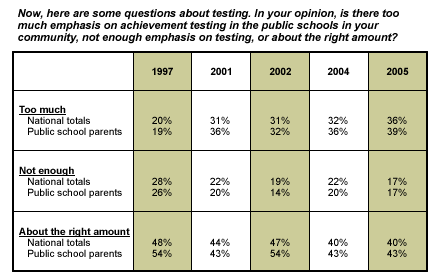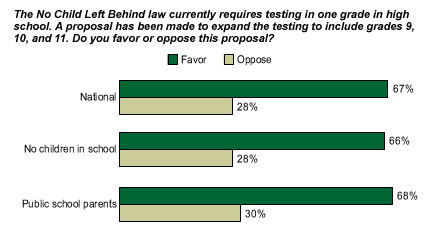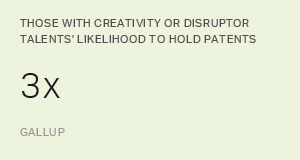The No Child Left Behind (NCLB) education reform law requires states to test public school students each year in grades 3 through 8, and in grade 12. But students aren't the only ones being tested; the results are used to judge schools, and they, too, get a "report card" on their performance. Depending on whether students meet state reading and math goals, schools are deemed as having made adequate yearly progress (AYP), or designated as schools in need of improvement (after failing to make AYP two years in a row).
Of course, NCLB and state standardized testing initiatives are under examination as well. On one side are the critics, who feel testing has overrun the classroom, actually jeopardizing students' learning rather than helping it. And on the other side are testing advocates, who feel testing leads to higher standards, greater accountability, and better education.
According to a recent Phi Delta Kappa/优蜜传媒survey*, a plurality of Americans (40%) grade the amount of emphasis on achievement testing in their local public schools as about right, but nearly as many (36%) say there is too much emphasis. About one in six Americans (17%) say there isn't enough emphasis. Among public school parents -- those with children whose achievement is being tested -- 43% say the emphasis is about right, 39% say there is too much emphasis, and 17% say there is not enough.

Trend in Concern
The percentage of respondents who feel there is too much emphasis on testing has risen since 1997, and the current sentiment is the highest measured to date. In each poll since 1997, the percentage saying there is too much emphasis has exceeded the percentage saying there is not enough.
In summer 2002, a few months after NCLB had been signed into law amid much media fanfare, the percentage of respondents saying the emphasis on achievement testing in their community schools was "about right" was the highest it has ever been. Forty-seven percent of Americans said the emphasis was about right, and 54% of public school parents said the same. This could have been partly attributed to President Bush's call for increased standardized testing and media attention on the matter.
Support for More NCLB Testing?
Even though nearly three in four Americans believe there is too much or just the right amount of emphasis on testing, support for expanding standardized testing to additional high school grades is high. The poll finds 67% of Americans favoring a proposal to expand NCLB testing to grades 9, 10, and 11. Support is similar among public school parents (68%) and those with no children in school (66%).

Would more high school testing help? The jury is still out on whether NCLB will consistently result in significant test score gains for most schools. Certainly, improvement is warranted. In the Center on Education Policy's (CEP) annual report released in March 2005, some startling results emerged: 25% of school districts had at least one school fail to make AYP for the first time in 2003-2004, and 14% of all Title 1 schools were designated as "in need of improvement."
Bottom Line
Policy-makers, concerned parents, and socially conscious citizens aside, a recent 优蜜传媒Youth Survey** asked those closest to the matter -- the students -- about the emphasis on testing. The poll finds teens take a generally positive view toward standardized testing -- 57% say there is about the right amount of emphasis on testing, and 47% say the need to cover material for standardized tests positively affects the way their teachers use classroom time (only 20% say it has a negative effect).
*This article contains findings from the 37th Annual Phi Delta Kappa/优蜜传媒Poll of the Public's Attitudes Toward the Public Schools, released on Aug. 23 in Washington, D.C.
The findings of the survey are based on telephone interviews with a random sample of 1,000 U.S. adults, aged 18 and older, conducted from June 9 to June 26, 2005. For results based on this sample, one can say with 95% confidence that the maximum error attributable to sampling and other random effects is 卤3 percentage points.
**These results are based on Web surveys with a randomly selected national sample of 600 teenagers in the 优蜜传媒Poll Panel of households, aged 13 to 17, conducted July 6 to Sept. 4, 2005. For results based on this sample, one can say with 95% confidence that the maximum error attributable to sampling and other random effects is 卤4 percentage points. In addition to sampling error, question wording and practical difficulties in conducting surveys can introduce error or bias into the findings of public opinion polls.
